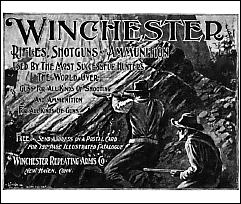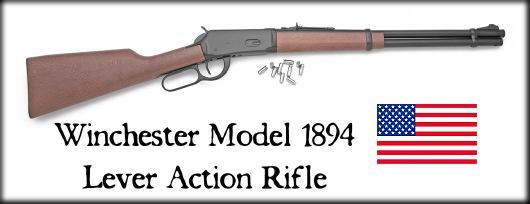Model 1894 Winchester Lever-Action Repeating Rifle. An Old West Classic that will Never Die.

1860 was a significant year in the
development of revolutionary
firearms technology. Benjamin Tyler "BT" Henry and the New
Haven Arms Company--formerly the Volcanic Arms Company--invented a
lever action repeating rifle. They created a whole new class
of ammunition for it, too, by capitalizing on the self-contained
cartridge invented by Daniel Wesson (of Smith and Wesson
fame). This was a tremendous advance in firearm technology
over the percussion, cap and ball firearms in widespread use at the
time. Henry further perfected the rimfire cartridge as a .44
caliber shell to be used in his new rifle. Prior to this
development by the New Haven Arms Company, gun users were required to
pack projectiles on top of powder charges, and ignite them with
percussion caps. And before that, they had to mess around
with loose black powder in the old flintlocks, even to ignite the main
powder charge. Though New Haven Arms did not know it at the
time, the 1860 Henry Rifle design was going places.
In 1866, Oliver Winchester, a main stockholder in the New Haven Arms Company, gained controlling interest, and the company was again renamed, this time as the Winchester Repeating Arms Company--a name that would last for 140 years. Building on the breakthrough technology of the 1860 Henry, Winchester produced the 1866 rifles and carbines--the first to bear the Winchester name. The 1866 was succeeded by the 1873, 1876, and other models. The Model 1892 Winchester was one of the most popular they made. In addition to the standard narrow-loop lever, the 1892 was produced with a large loop that was later popularized by the TV show "The Rifleman" and numerous John Wayne movies. Light, agile and easy to use, the Model 1892 was so popular with Wayne and numerous other TV and movie cowboys that it was often used in stories set well before the model was actually introduced. The 1892 continued in production until 1941.
Winchester rifles produced from 1873
through 1894 and beyond,
are generally credited as being the "Guns that Won the West. A lot of
the Coilt SAA .45 pistols got the same nickname, as the pistol version.
The 1894
Model Winchester Rifle (designed under patent by John Browning),
really took off, since it was designed to use cartridges packed with
the new smokeless gunpowder that debuted in 1895.

The Model 1894 allowed
the cycling of longer cartridges than its
successful predecessor, the 1892. With the success of the
fully self-contained rimfire rounds firmly under their belts,
Winchester rolled out a new and more powerful version--the centerfire
cartridge. Although many different calibers were tested in the model
1894, the most successful--and now most common--is the 30-30 WCF, or
"Winchester Centerfire" 30 caliber projectile. The .30
caliber
cartridge was packed
with 30 grains of smokeless powder, hence the name 30-30.
To accommodate the
increased pressure from
the more
powerful shells, the Model 1894 also is a
stronger rifle. It holds cartridges in a linear magazine just
beneath the barrel, expels spent casings through an ejection port, and
chambers new rounds with its now-famous lever action.
To further Winchester's image, several Model 1894s with milestone production numbers were presented to American presidents. The one-millionth was presented to President Calvin Coolidge in 1927; number 1,500,000 went to President Harry Truman in 1948, and number 2,000,000 to President Dwight Eisenhower in 1953.
The Model 1894 went through a few small changes, but largely remained the same. It achieved legendary popularity and success as a sporting rifle, and even saw a little military use in the Pacific Northwest "Spruce Gund" industries for national defense, which is a long story in itself. The name was shortened colloquially to the "Model '94" or just the '94. It was (and still is) the single most successful sporting/game rifle in history, and holds the records to prove it. Between 1894 and 2006, there were over 7.5 million Winchester '94 rifles produced. In the 2005 Winchester catalog, just before the company closed down, there were 14 different models of the '94. That's in addition to other rifles and shotguns they produced. The Winchester '94 is now practically synonymous with "deer rifle." It is the best-selling high-powered rifle in US history.
There were a number of spinoffs from the Winchester success. Horace Smith and Daniel Wesson, original founders in 1852 of the Volcanic Repeating Arms Company that would become the New Haven Arms Com pany, went on in 1856 to start up a company that would eventually be known as "Smith and Wesson", now a household word. John M. Browning, a Winchester Repeating Arms Company partner, was the most influential gun designer in modern history. In addition to the Model 1894, he is also credited with designing the now-legendary Colt M1911 semi-automatic pistol, and many other groundbreaking designs. His specialty was slide-action, auto loading firearms--designs that are still used in virtually every automatic pistol manufactured today. In addition to contracting his services as an expert designer to Winchester, Colt, Savage (who made some of the Lee-Enfield SMLE rifles), Remington, Fabrique Nationale, a Belgian company, he also had his own company, The Browning Arms Company.
1964 was a sour turning point for Winchester. Having had phenomenal success in the past and facing increasing competition from all sides, the management, in a controversial move, decided to take cost-cutting measures, and made small design changes to the model '94. These changes lessened the quality of the rifle, and resulted in a cultural rift for their customers. Many of them consider only those made before 1964 to be "real" Winchesters. Pre-1964 Winchester 94s were (and still are) more valued and preferred than those made after that year.
The company continued to experience trouble for decades. Their attempts to recover included the introduction of new models--such as the 1970s Super X-1 semi-auto shotgun with "pre-1964" characteristics. It was well received, but had only limited success, and they increasingly had trouble sustaining production costs.
After splitting up the Winchester company into smaller parts and selling them off in 1980, the Winchester name remained only as a successful producer of ammunition. The firearms production arm of the company was reinvented as US Repeating Arms, but the new incarnation continued to experience changing management and ownership, until the company finally closed its doors in New Haven, Connecticut in 2006. Olin Corporation--owner of the Winchester name--entered into a licensing agreement with Morgan, Utah-based Browning, owned by FN Herstal a subsidiary of Herstal Group in Liege, Belgium, and is now producing the model 94 rifles in Columbia, SC.
Even if the original Winchester company is no more, the name still lives on with production under different companies. Winchester 94 rifles are still in use worldwide--especially in the United States, where they are still considered the quintessential hunting rifle. The Winchester rifle is outliving the company that started it.
Firearm Type:
Lever-Action Rifle
Nation Of Manufacture: USA
Military Service Dates : Used
briefly by military contractors for guard duty 1917-1919
Variations: Model 1894, commemorative
models, many others
Ammunition: 30-30 Center-Fire, others
Wars: Sporting and Hunting Rifle
Recent Prices at Auction for Originals: US
$1,000-$30,000
We offer an authentic blank-firing
replica Winchester Model 1894 rifle.